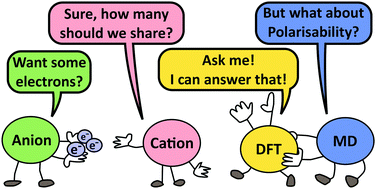Charge transfer and polarisability in ionic liquids: a case study†
Abstract
The practical use of ionic liquids (ILs) is benefiting from a growing understanding of the underpinning structural and dynamic properties, facilitated through classical molecular dynamics (MD) simulations. The predictive and explanatory power of a classical MD simulation is inextricably linked to the underlying force field. A key aspect of the forcefield for ILs is the ability to recover charge based interactions. Our focus in this paper is on the description and recovery of charge transfer and polarisability effects, demonstrated through MD simulations of the widely used 1-butyl-3-methylimidazolium bis(trifluoromethanesulfonyl)imide [C4C1im][NTf2] IL. We study the charge distributions generated by a range of ab initio methods, and present an interpolation method for determining atom-wise scaled partial charges. Two novel methods for determining the mean field (total) charge transfer from anion to cation are presented. The impact of using different charge models and different partial charge scaling (unscaled, uniformly scaled, atom-wise scaled) are compared to fully polarisable simulations. We study a range of Drude particle explicitly polarisable potentials and shed light on the performance of current approaches to counter known problems. It is demonstrated that small changes in the charge description and MD methodology can have a significant impact; biasing some properties, while leaving others unaffected within the structural and dynamic domains.



 Please wait while we load your content...
Please wait while we load your content...